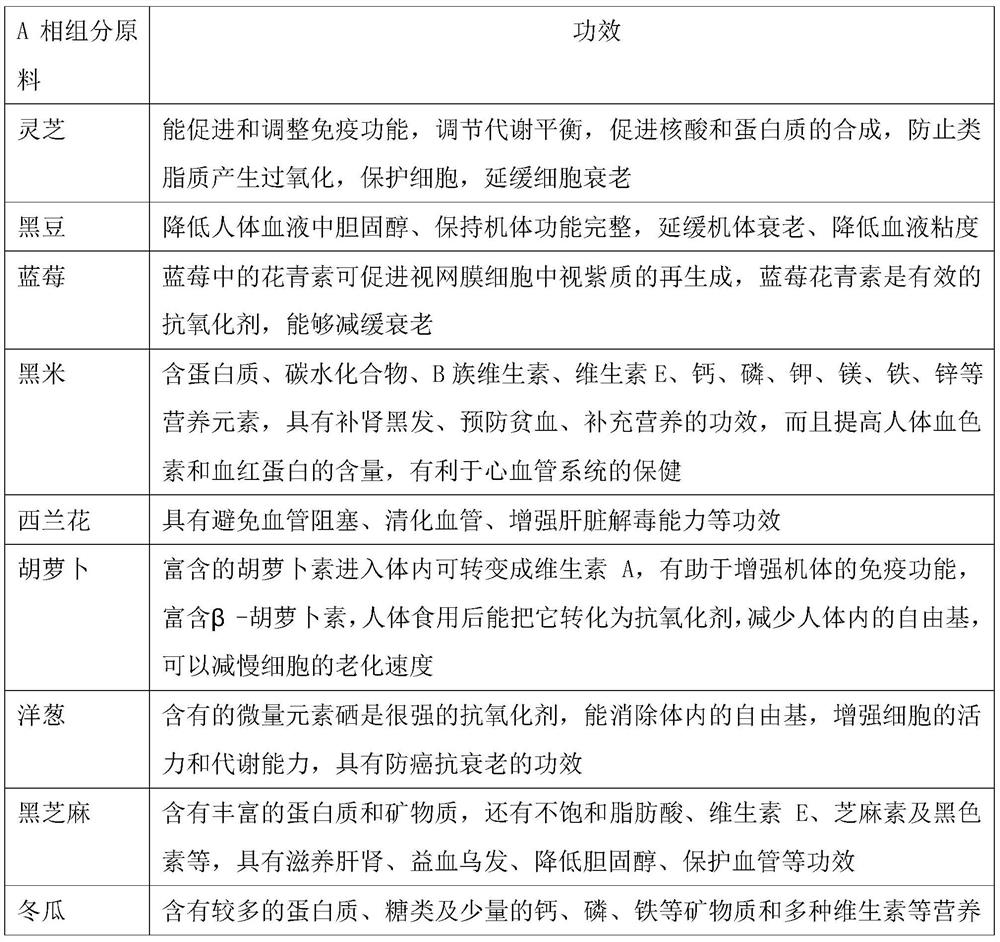Whole grain powder for repairing telomeres and preparation method thereof
A technology of whole grains and telomeres, which is applied in the field of whole grains powder, can solve the problems of affecting cell life and telomerase activity affecting telomeres, and achieve the effects of regulating metabolic balance, protecting cells, and balanced nutrition
- Summary
- Abstract
- Description
- Claims
- Application Information
AI Technical Summary
Problems solved by technology
Method used
Image
Examples
Embodiment 1
[0029] The invention provides a whole grain powder for repairing telomeres, which comprises phase A component and phase B component, and the phase A component is composed of the following components according to weight percentage: 10% of ganoderma lucidum, 10% of black soybean, and 3% of blueberry , black rice 15%, broccoli 6%, carrot 10%, onion 0.5%, black sesame 3% and wax gourd 5%;
[0030] The B-phase component is composed of the following components according to weight percentage: 3% white sesame, 7% soybean, 10% oat, 6% mung bean, 5% peanut, 0.3% rose, 2% lemon balm, 0.5% lemon, Lotus 0.3, sweet potato 6%, corn 10%, asparagus 2%, cauliflower 1%, eggplant 0.5%, beet 1%, shepherd's purse 0.3%, kohlrabi 1%, potato 3%, enoki mushroom 0.5%, potherb mustard 0.1%, apple 1%, 0.5%-3% of tomato, 0.1% of walnut, 0.5% of lotus root, 0.1% of ginger, 1% of rape and 1% of dried kiwi.
[0031] The present invention also provides a preparation method of whole grain powder for repairing ...
Embodiment 2
[0045] The difference from Example 1 is that the phase A components are composed of the following components according to weight percentage: Ganoderma lucidum 12.5%, black beans 12.5%, blueberries 5.5%, black rice 18%, broccoli 9%, carrots 13%, onions 0.8% %, black sesame 4.5% and wax gourd 6.5%;
[0046] The B-phase component is composed of the following components according to weight percentage: 9% white sesame, 12% soybean, 17.5% oat, 12% mung bean, 8% peanut, 2.5% rose, 5% lemon balm, 2.5% lemon, Lotus 1.5%, sweet potato 8%, corn 15%, asparagus 5%, cauliflower 5.5%, eggplant 2.5%, beet 3%, shepherd's purse 2.5%, kohlrabi 3%, potato 5%, enoki mushroom 2.5%, potherb mustard 1%, Apple 3%, tomato 1.5%, walnut 1.5%, lotus root 1.2%, ginger 0.3%, rape 2% and dried kiwi 3%.
Embodiment 3
[0048] The difference from Examples 1-2 is that the A-phase component is composed of the following components according to weight percentage: Ganoderma lucidum 15%, black beans 15%, blueberries 8%, black rice 20%, broccoli 12%, carrots 16% , onion 1%, black sesame 6% and wax gourd 8%;
[0049] The B-phase component is composed of the following components according to weight percentage: 15% white sesame, 17% soybean, 25% oat, 18% mung bean, 11% peanut, 5% rose, 8% lemon balm, 5% lemon, Lotus 3%, sweet potato 10%, corn 20%, asparagus 8%, cauliflower 10%, eggplant 5%, beet 5%, shepherd's purse 5%, kohlrabi 5%, potato 7%, enoki mushroom 5%, potherb mustard 2%, Apple 5%, tomato 3%, walnut 3%, lotus root 2%, ginger 0.5%, rape 3% and kiwi fruit 5%.
PUM
 Login to View More
Login to View More Abstract
Description
Claims
Application Information
 Login to View More
Login to View More - R&D
- Intellectual Property
- Life Sciences
- Materials
- Tech Scout
- Unparalleled Data Quality
- Higher Quality Content
- 60% Fewer Hallucinations
Browse by: Latest US Patents, China's latest patents, Technical Efficacy Thesaurus, Application Domain, Technology Topic, Popular Technical Reports.
© 2025 PatSnap. All rights reserved.Legal|Privacy policy|Modern Slavery Act Transparency Statement|Sitemap|About US| Contact US: help@patsnap.com


